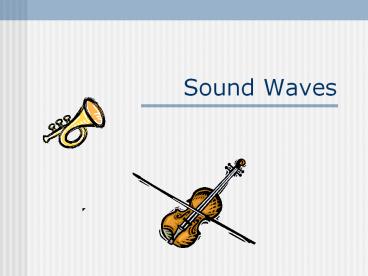Sound Waves - PowerPoint PPT Presentation
Title:
Sound Waves
Description:
Sound Waves The Nature of Sound Sound Waves Created by a vibrating object such as the string on a violin, your vocal chords or the diaphragm of a loudspeaker. – PowerPoint PPT presentation
Number of Views:308
Avg rating:3.0/5.0
Title: Sound Waves
1
Sound Waves
2
The Nature of Sound
- Sound Waves
- Created by a vibrating object such as the string
on a violin, your vocal chords or the diaphragm
of a loudspeaker. - Sound waves can be transmitted through gases,
liquids and solids. - If there is no medium, there is no sound.
3
How is Sound Transmitted?
- Sound is created by the cyclical collisions of
atoms and molecules such that it is transmitted
through the bulk matter.
http//www.acs.psu.edu/drussell/Demos/superpositio
n/superposition.html
http//www.indiana.edu/emusic/acoustics/phase.htm
http//www.acs.psu.edu/drussell/Demos/waves/wave
motion.html
4
Sound generator characteristics
- Tuning Fork
- Look at the vibration in front of a display
screen - Repeated pattern
- Requires a medium
- What if I take the air away?
5
Sound effects
- Focus
- Old Senate chamber
- Reflect
- Echo
- Refract
- Over a hill, other unusual effects
6
Speed of Sound
- Speed of sound depends on the medium through
which it travels. - ?kT
- m
- Where
- k Boltzmans constant (1.38 x 10-23
J/K) - ? Cp/Cv (5/3 for ideal monotonic
gases) - T Temperature (K)
- m Average mass of air (28.9 amu)
Air Water Steel
Speed (m/s) 343 1482 5960
7
Speed of sound
- Can it be directly measured?
- What is an echo, and how could I use this to find
the speed of sound?
8
Sound Wave Characteristics
- Condensation or Compression Region of the wave
where air pressure is slightly higher. - Rarefaction Region of the air wave where the
pressure is slightly lower. - Pure Tone A sound wave with a single frequency.
- Pitch An objective property of sound associated
with frequency. Pitch - High frequency high pitch.
- Low frequency low pitch. Per 1
- Loudness The attribute of sound that is
associated with the amplitude of the wave. - Beat When two sound waves overlap with a
slightly different frequency. Beats Per 2
9
Standing Waves in Musical Instruments
- Resonance Stringed instruments, such as the
guitar, piano or violin, and horn and wind
instruments such as the trumpet, oboe, flute and
clarinet all form standing waves when a note is
being played. - The standing waves are of either the type that
are found on a string, or in an air column (open
or closed). - These standing waves all occur at natural
frequencies, also known as resonant frequencies,
associated with the instrument.
10
Standing Wave Characteristics
- Harmonic The series of frequencies where
standing waves recur (1f, 2f, 3f,). Where the
first frequency is called the first harmonic
(1f), the second frequency is called the second
harmonic (2f), and so on. - The first harmonic the first fundamental
frequency (n 1). - Overtones The harmonic frequency 1.
11
Harmonics and Overtones of Standing Waves
This is like a string Fixed at both ends
12
Longitudinal Standing Waves
- Wind instruments, such as the flute, oboe,
clarinet, trumpet, etc. develop longitudinal
standing waves. - They are a column of air.
- May be open at one or both ends.
- Wave will reflect back regardless as to whether
or not it is open or close ended.
13
Longitudinal Standing Waves Open Tube
- In an open tube instrument like the flute, the
harmonics follow the following relationship - fn n(v/2L) n 1, 2, 3,
Wavelength V 342 m/sec Fundamental Frequency
Wavelength Frequency Wavelength
Frequency Wavelength Frequency
- Longitudinal Standing Wave Applet
14
Longitudinal Standing Waves Tube Closed on One
End
- In a closed tube instrument like the clarinet or
oboe, the harmonics follow the following
relationship - fn n(v/4L) n 1, 3, 5,
Wavelength V 342 m/sec Fundamental Frequency
Wavelength Frequency Wavelength
Frequency Wavelength Frequency
15
The Doppler Effect http//www.falstad.com/ripple/
ex-doppler.html
http//www.astro.virginia.edu/class/whittle/astr12
20/05_Light_Matter/hearingthedopplereffect.html
16
Doppler Shift
- The change in sound frequency due to the relative
motion of either the source or the detector.
17
Key Ideas
- Sound waves are generated by a vibrating object
such as the string on a violin, your vocal chords
or the diaphragm of a loudspeaker. - Sound waves can be transmitted through gases,
liquids and solids. - If there is no medium, there is no sound.
- Sound is generated by the cyclical collisions of
atoms and molecules. - Condensation and rarefaction denote portions of
the wave that are of slightly higher and lower
pressure, respectively.
18
Key Ideas
- Sound waves travel at different speeds in
different mediums. - They speed up when going from air to a liquid to
a solid. - Pure tone is sound of a single frequency.
- Pitch and loudness are characteristics of sound
that represent its frequency and amplitude,
respectively. - When two sound waves overlap slightly due to
mildly different frequencies, they generate a
beat. - Harmonics occur at multiples of the natural
frequency.































